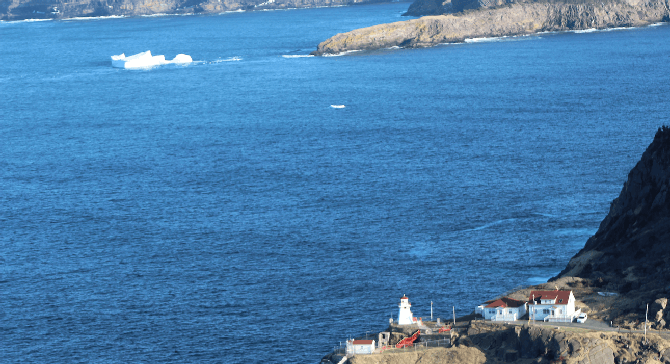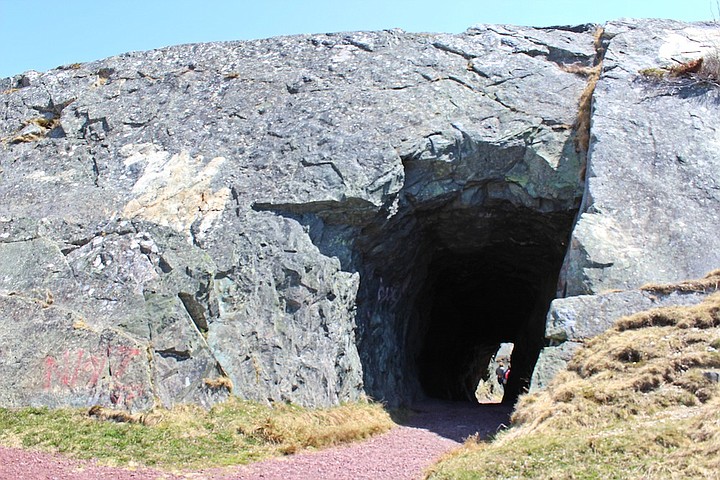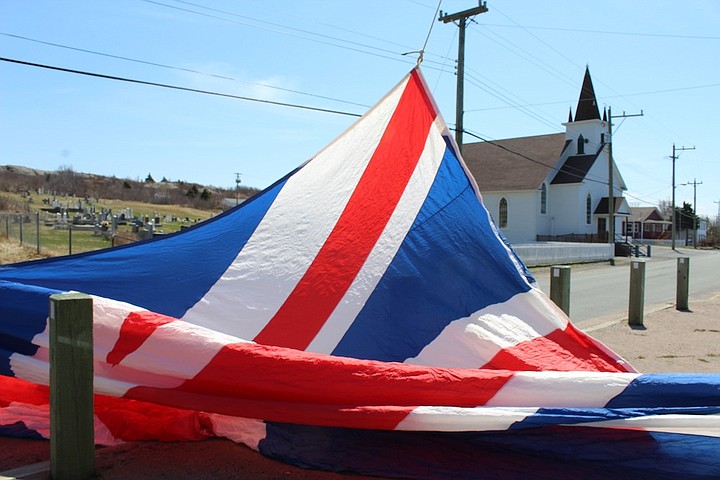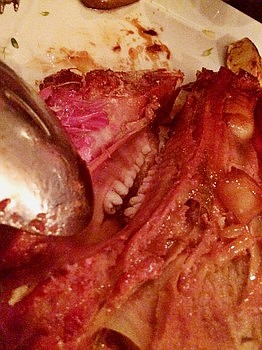 Facebook
Facebook
 X
X
 Instagram
Instagram
 TikTok
TikTok
 Youtube
Youtube

As the easternmost part of North America, the Canadian Maritime province of Newfoundland seems so far away, but it’s the nearest to Europe. Its hardy, thrifty residents – who were isolated in winter – were bulwarks against all kinds of European atrocities for over 1,000 years. This beautiful, rugged island helped give us the freedoms and luxuries we all enjoy today.
Vikings first arrived and wrote about it in the Icelandic Sagas. In the 15th century, Portuguese fishermen were blown there accidentally and found the area to be teeming with lucrative cod. Newfoundland was clearly a bulwark against European starvation.
It was with this heritage in mind that I traveled there with folks from the Terroir Symposium, an organization working with the hospitality industry, including gourmet chefs of North America and Europe. We were seeking the secrets of Newfoundland’s land, sea and its people.
French fishermen and England’s Sir George Calvert – 1st Lord Baltimore and charter holder of the Maryland colony – were able to practice Catholicism in Newfoundland. So, similarly, the island was a bulwark against religious persecution, too. During the 1930s, there was a major attempt by Jews on Newfoundland’s west coast to convince the British government to open the west coast to Jewish refugees from Europe; nothing came of this attempt.
Newfoundland was an independent Commonwealth Dominion until becoming a Canadian province in 1949. They’re on Newfoundland Standard Time Zone: an hour and a half past EST. As locals say, “We have a half hour extra to do everything!”
Even in summer, definitely dress in layers. Winter-like winds are common in the North Atlantic.
Outside St. John’s is a fantastic walking trail at Signal Hill. The national historic site has narrow bluffs overlooking the North Atlantic where you might spot an iceberg! Marconi received his first transatlantic wireless signal here.

Rent a car and drive up the scenic coast to Brigus, the town with an older English “brick house” name. Reminiscent of coastal Scandinavian towns with their cute, colorful homes, just hiking there in the fresh sea air is a lot of fun. Check out the hand-blasted tunnel that famed ice mariner Abram Bartlett made to more easily access the sea from his super-remote house.

Check out the giant Union Jack flag! If you’re in the town of Cupids during one of the special national holidays – such as Canada Day – you can see the raising of (a replica of) the second-largest flag in the British Empire. It’s flown right on the harbor. The original huge standard was given in 1910, the 300th anniversary of British settlement at Cupids. The original flag is on display at the Cupids Legacy Centre. When there, don’t pass up the opportunity to listen to the audio guide narrated by museum manager Peter Laracy. As storyteller par excellence, he shines a light on the quirkiness of the region. The rooftop Faerie Garden is spectacular for vistas of the area and photos.
What do you look for in a town’s museum? Is it art, history, special archives? See it all at once at St. John’s The Rooms. You’ll see how the indigenous people lived, the transition to becoming part of Canada, the beauty of the local nature that artists have captured.
In Newfoundland there’s a fine harvest of seafood at certain times of the year, a modest harvest of produce at other times of the year and folks make do the rest of the time. Also, restrictive Canadian fishing laws makes it so Newfoundlanders often can’t either fish or locally distribute what’s in their waters. Wild game is very popular and, surprisingly, seal.

When you’re eating adventurously, it’s a great idea to try new things in a casual atmosphere (with good drinks, to be sure!). Chinched Bistro in St. John’s has all kinds of local wild game, whole roasted hog – with teeth left in the head, no less! – and even seal offal. Seal is, um, challenging. It’s got very strong game meat and fish flavors in one bite. Newfoundlanders eat animals and parts of animals that folks in more temperate climes have resisted. In Chinched Bistro's endeavors to "preserve the old ways," they make their own pickles, ice cream, crackers and wild game charcuterie.
Gourmands know that the best meals occur at both ends of the spectrum: the white tablecloth restaurant featuring the rare delicacies of the globe AND the local heritage recipes presented in a home-spun ambiance. Cupid's Haven in Cupid serves the ultimate comfort food in the ultimate comforting environment: the former St. Augustine's Church! Cupid is about an hour away from St. John's. Certainly during harsher weather, this can feel like a more remote part of the world. But community and thriftiness reign supreme here. The area brings to mind the New England Shaker hymn Simple Gifts’ opening stanza: "'Tis the gift to be simple, 'tis the gift to be free/ 'Tis the gift to come down where we ought to be."
Cupid’s Haven serves Northern Atlantic coastal classic dishes like salt fish cakes, baked beans, pan-fried cod. When I was there, they had a (good for what ails ya) turkey and homemade dumplings with local salt pork, carrots in a rich broth. Try that on a blustery day! This was followed by "touten": leftover fried dough from that day's bread making. It's served with butter and that integral part of the historic "Rum Triangle"– molasses. Molasses provides nutritious iron to diets. Way down the coast in the U.S.'s New England, there’s a saying, "Use it up, wear it out, make it do or do without." Folks from the rural parts of Newfoundland have a similar old saying invoking their beloved frugal snack: "Have a touten, do withouten."
Also near St. John’s in Petty Harbor is Chafe’s Landing. The Chafe family has been in the area for about, oh, 400 years. The seafood is family caught, family cooked. Imagine if your dad went out the night before, caught some cod, then fried you up some fish and chips. Simple, but oh so good! The portions are tremendous, but they modestly deny it.
Quidi Vidi (pronounced like “itty bitty”) is a historic little fishing village just minutes outside of St. John’s. I went to Mallard Cottage for brunch, a laid-back restaurant in an Irish-Newfoundland style cottage dating back to the 18th century. It’s said to be one of the oldest wooden structures still standing in North America. They use Newfoundland wild game, seafood, produce and even sea salt in both traditional and fun ways. Their menu is eclectic, prodigious and inventive, but presentation isn’t fancy. Brunch amusingly seems like your hip chef friend invited you over “the day after” and appears to have gotten a huge case of the munchies. How many cake slices will you order along with fried duck eggs and house pate? Probably a few!
Just in case you thought that an island far up in the North Atlantic would be all on the casual side, Raymonds is a reason to bring the chic outfit and fabulous shoes. The clubby bar up front serves mixologist cocktails with rare liqueurs from around the world... but do you know what’s local? The purest ice made from icebergs floating by! One guy harvests that ice, because it’s dangerous business. You know the saying “the tip of the iceberg”? That’s because only 1/8 of an iceberg shows above the surface. That was the Titanic’s downfall, not far off the coast of Newfoundland.
Once you enter Raymond’s triple-high ceiling dining room with modern chandeliers, you realize this is a place where cuisine is taken seriously. Let their sommelier help you select wines: their collection is enviable. Freshly shucked local oysters have very deep, lacy cups with a meaty taste – similar to Europe’s. They’re presented with freshly grated horseradish along with the traditional garnishes. Entrees use local meats and seafood, adorning them with Canadian luxury touches like duck and Sturgeon caviar.
The Sheraton Hotel Newfoundland is considered one of the finest accommodations in the province. The hotel itself – way high up on a hill – is on the site of what was the 17th century Fort William, a British Army base. Besides an indoor heated pool, there’s an indoor tropical garden surrounding the dining area, making for a toasty oasis when the outdoors is frigid. The club-level lounge overlooks the busy harbor.


As the easternmost part of North America, the Canadian Maritime province of Newfoundland seems so far away, but it’s the nearest to Europe. Its hardy, thrifty residents – who were isolated in winter – were bulwarks against all kinds of European atrocities for over 1,000 years. This beautiful, rugged island helped give us the freedoms and luxuries we all enjoy today.
Vikings first arrived and wrote about it in the Icelandic Sagas. In the 15th century, Portuguese fishermen were blown there accidentally and found the area to be teeming with lucrative cod. Newfoundland was clearly a bulwark against European starvation.
It was with this heritage in mind that I traveled there with folks from the Terroir Symposium, an organization working with the hospitality industry, including gourmet chefs of North America and Europe. We were seeking the secrets of Newfoundland’s land, sea and its people.
French fishermen and England’s Sir George Calvert – 1st Lord Baltimore and charter holder of the Maryland colony – were able to practice Catholicism in Newfoundland. So, similarly, the island was a bulwark against religious persecution, too. During the 1930s, there was a major attempt by Jews on Newfoundland’s west coast to convince the British government to open the west coast to Jewish refugees from Europe; nothing came of this attempt.
Newfoundland was an independent Commonwealth Dominion until becoming a Canadian province in 1949. They’re on Newfoundland Standard Time Zone: an hour and a half past EST. As locals say, “We have a half hour extra to do everything!”
Even in summer, definitely dress in layers. Winter-like winds are common in the North Atlantic.
Outside St. John’s is a fantastic walking trail at Signal Hill. The national historic site has narrow bluffs overlooking the North Atlantic where you might spot an iceberg! Marconi received his first transatlantic wireless signal here.

Rent a car and drive up the scenic coast to Brigus, the town with an older English “brick house” name. Reminiscent of coastal Scandinavian towns with their cute, colorful homes, just hiking there in the fresh sea air is a lot of fun. Check out the hand-blasted tunnel that famed ice mariner Abram Bartlett made to more easily access the sea from his super-remote house.

Check out the giant Union Jack flag! If you’re in the town of Cupids during one of the special national holidays – such as Canada Day – you can see the raising of (a replica of) the second-largest flag in the British Empire. It’s flown right on the harbor. The original huge standard was given in 1910, the 300th anniversary of British settlement at Cupids. The original flag is on display at the Cupids Legacy Centre. When there, don’t pass up the opportunity to listen to the audio guide narrated by museum manager Peter Laracy. As storyteller par excellence, he shines a light on the quirkiness of the region. The rooftop Faerie Garden is spectacular for vistas of the area and photos.
What do you look for in a town’s museum? Is it art, history, special archives? See it all at once at St. John’s The Rooms. You’ll see how the indigenous people lived, the transition to becoming part of Canada, the beauty of the local nature that artists have captured.
In Newfoundland there’s a fine harvest of seafood at certain times of the year, a modest harvest of produce at other times of the year and folks make do the rest of the time. Also, restrictive Canadian fishing laws makes it so Newfoundlanders often can’t either fish or locally distribute what’s in their waters. Wild game is very popular and, surprisingly, seal.

When you’re eating adventurously, it’s a great idea to try new things in a casual atmosphere (with good drinks, to be sure!). Chinched Bistro in St. John’s has all kinds of local wild game, whole roasted hog – with teeth left in the head, no less! – and even seal offal. Seal is, um, challenging. It’s got very strong game meat and fish flavors in one bite. Newfoundlanders eat animals and parts of animals that folks in more temperate climes have resisted. In Chinched Bistro's endeavors to "preserve the old ways," they make their own pickles, ice cream, crackers and wild game charcuterie.
Gourmands know that the best meals occur at both ends of the spectrum: the white tablecloth restaurant featuring the rare delicacies of the globe AND the local heritage recipes presented in a home-spun ambiance. Cupid's Haven in Cupid serves the ultimate comfort food in the ultimate comforting environment: the former St. Augustine's Church! Cupid is about an hour away from St. John's. Certainly during harsher weather, this can feel like a more remote part of the world. But community and thriftiness reign supreme here. The area brings to mind the New England Shaker hymn Simple Gifts’ opening stanza: "'Tis the gift to be simple, 'tis the gift to be free/ 'Tis the gift to come down where we ought to be."
Cupid’s Haven serves Northern Atlantic coastal classic dishes like salt fish cakes, baked beans, pan-fried cod. When I was there, they had a (good for what ails ya) turkey and homemade dumplings with local salt pork, carrots in a rich broth. Try that on a blustery day! This was followed by "touten": leftover fried dough from that day's bread making. It's served with butter and that integral part of the historic "Rum Triangle"– molasses. Molasses provides nutritious iron to diets. Way down the coast in the U.S.'s New England, there’s a saying, "Use it up, wear it out, make it do or do without." Folks from the rural parts of Newfoundland have a similar old saying invoking their beloved frugal snack: "Have a touten, do withouten."
Also near St. John’s in Petty Harbor is Chafe’s Landing. The Chafe family has been in the area for about, oh, 400 years. The seafood is family caught, family cooked. Imagine if your dad went out the night before, caught some cod, then fried you up some fish and chips. Simple, but oh so good! The portions are tremendous, but they modestly deny it.
Quidi Vidi (pronounced like “itty bitty”) is a historic little fishing village just minutes outside of St. John’s. I went to Mallard Cottage for brunch, a laid-back restaurant in an Irish-Newfoundland style cottage dating back to the 18th century. It’s said to be one of the oldest wooden structures still standing in North America. They use Newfoundland wild game, seafood, produce and even sea salt in both traditional and fun ways. Their menu is eclectic, prodigious and inventive, but presentation isn’t fancy. Brunch amusingly seems like your hip chef friend invited you over “the day after” and appears to have gotten a huge case of the munchies. How many cake slices will you order along with fried duck eggs and house pate? Probably a few!
Just in case you thought that an island far up in the North Atlantic would be all on the casual side, Raymonds is a reason to bring the chic outfit and fabulous shoes. The clubby bar up front serves mixologist cocktails with rare liqueurs from around the world... but do you know what’s local? The purest ice made from icebergs floating by! One guy harvests that ice, because it’s dangerous business. You know the saying “the tip of the iceberg”? That’s because only 1/8 of an iceberg shows above the surface. That was the Titanic’s downfall, not far off the coast of Newfoundland.
Once you enter Raymond’s triple-high ceiling dining room with modern chandeliers, you realize this is a place where cuisine is taken seriously. Let their sommelier help you select wines: their collection is enviable. Freshly shucked local oysters have very deep, lacy cups with a meaty taste – similar to Europe’s. They’re presented with freshly grated horseradish along with the traditional garnishes. Entrees use local meats and seafood, adorning them with Canadian luxury touches like duck and Sturgeon caviar.
The Sheraton Hotel Newfoundland is considered one of the finest accommodations in the province. The hotel itself – way high up on a hill – is on the site of what was the 17th century Fort William, a British Army base. Besides an indoor heated pool, there’s an indoor tropical garden surrounding the dining area, making for a toasty oasis when the outdoors is frigid. The club-level lounge overlooks the busy harbor.
Comments